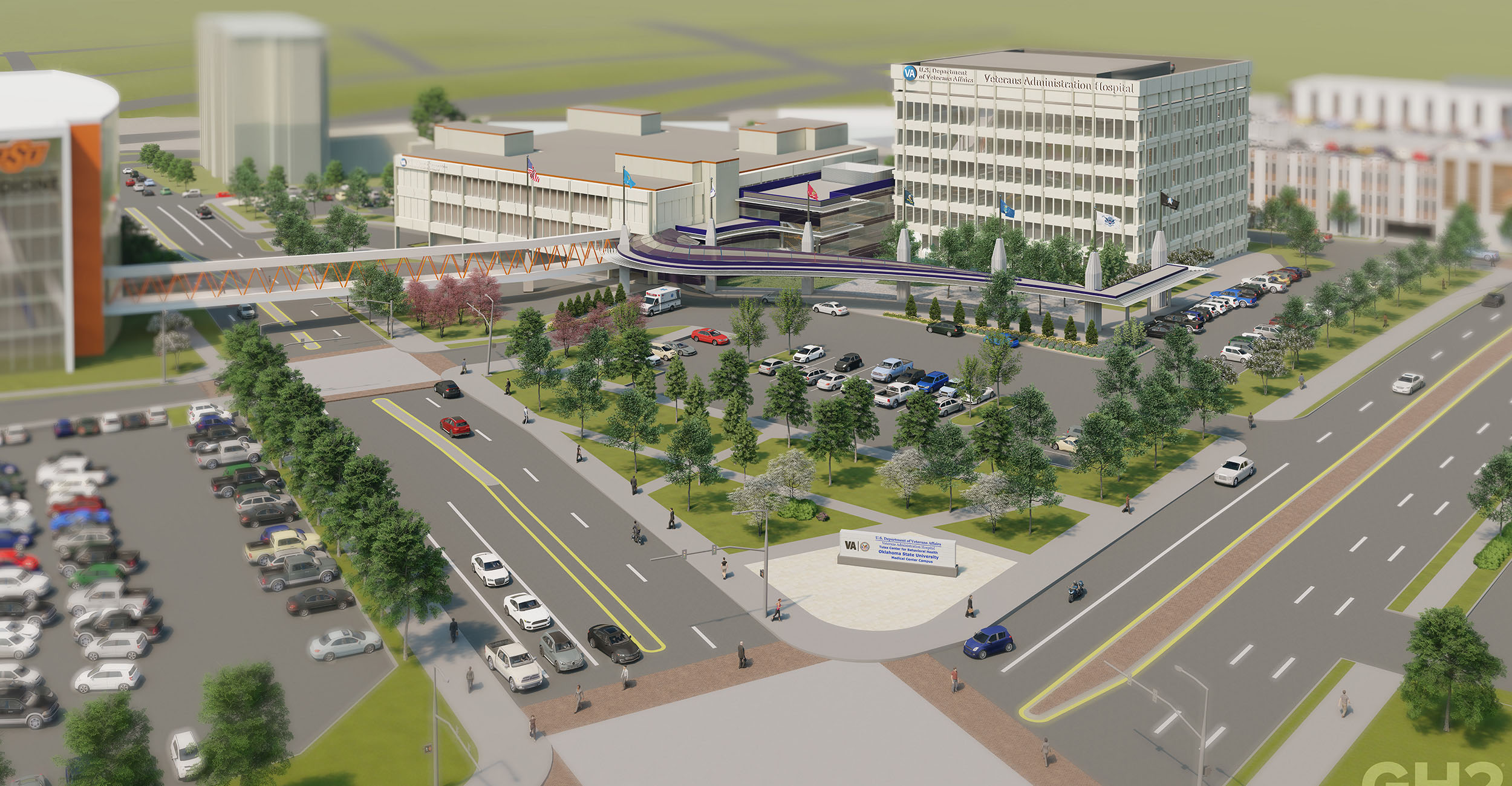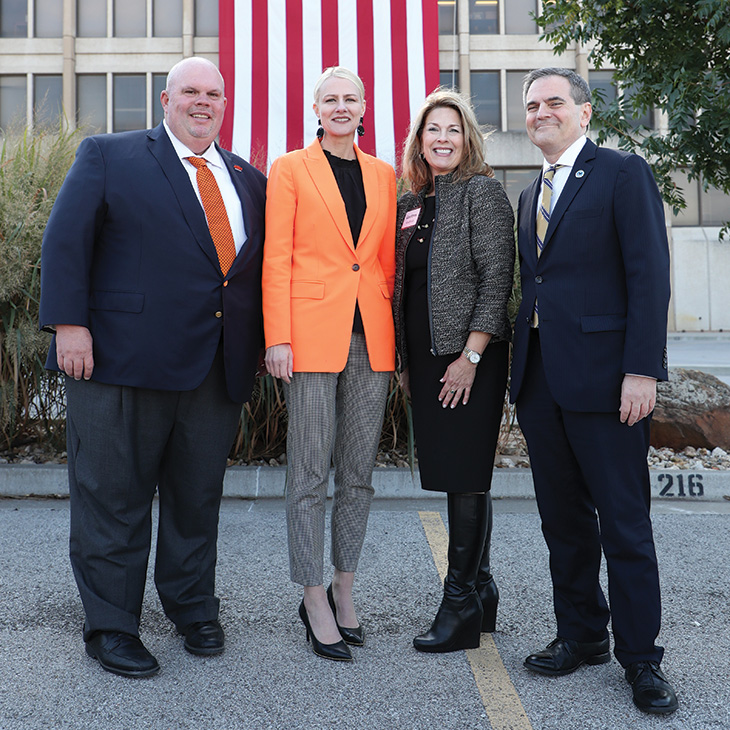
OSU Academic Medical District to serve veterans, improve mental health care
Wednesday, April 27, 2022
Media Contact: Mack Burke | Editorial Coordinator | 405-744-5540 | editor@okstate.edu
A couple of recently vacated buildings and parking lots sit across the street to the north of the Oklahoma State University Medical Center (OSUMC) in downtown Tulsa. It may not look like much now, but in the coming years it will become the hub of the new OSU Academic Medical District.
In October 2021, a ceremonial groundbreaking was held where two existing buildings, donated by the state and just across the street from OSUMC, will be renovated into the new Veterans Hospital in Tulsa.
Next to the VA hospital will be a new mental health hospital operated by the Oklahoma Department of Mental Health and Substance Abuse Services.
OSU Medicine physicians and residents, as well as third- and fourth-year medical students on rotation, will
treat patients at both new facilities. An estimated 100 additional residency spots will be created between the new VA and mental health hospitals, along with about 30 new clinical faculty positions.
OSU already has established itself in the southwest corner of downtown Tulsa with the OSU Medical Center as well as 10 primary care and specialty OSU Medicine clinics in the Physicians Office Building and Houston Center just steps away from the hospital.

“The mission of OSU Center for Health Sciences and the College of Osteopathic Medicine is to improve the health and wellbeing of those living in rural and underserved Oklahoma through quality health care. It’s an essential part of the land-grant mission of Oklahoma State University,” said Dr. Johnny Stephens, president of OSU-CHS.
While improving rural medicine will always be a core tenant of OSU-CHS, Stephens said he saw an opportunity for OSU to help meet the health care needs of veterans and those with mental health disorders in the Tulsa area by establishing the OSU Academic Medical District.
Serving Those Who Served
In February 2020, the presidential budget submitted to the U.S. Congress for 2021 included a $120 million appropriation for the construction of a Veterans Hospital in Tulsa (VHiT).
It’s the first hospital built under the CHIP-IN Act — Communities Helping Invest through Property and Improvements Needed for Veterans Act of 2016.
U.S. Sens. Jim Inhofe and James Lankford — as well as U.S. Reps. Markwayne Mullin and Kevin Hern — supported the proposal to build a VA hospital in downtown Tulsa and worked to secure the appropriation along with the Eastern Oklahoma VA Health Care System, VA Rocky Mountain Network and Veterans Health Administration.
“An overwhelming majority of veterans in eastern Oklahoma live in the Tulsa metropolitan area and do not have access to hospital care at a VA facility. Having a VA hospital centrally located in Tulsa will allow eastern Oklahoma veterans greater access to care and services that are currently not available,” said Jonathan Plasencia, associate director of Eastern Oklahoma VA Health Care System.
In order to make the hospital a reality, more than just the federal appropriation
was needed. The state of Oklahoma transferred ownership of the Kerr-Edmondson buildings
in downtown Tulsa to OSU. Next, the city of Tulsa will construct an $8 million parking
structure on the site. Tulsa County has committed $4 million from its American Rescue
Plan Act allocation to go toward project infrastructure funding.
The remaining costs will be covered by philanthropic donations, led by the Anne & Henry Zarrow Foundation, which helped form the Veterans Hospital in Tulsa, LLC.
Construction and renovation work on the new VA hospital is under way and is slated to be completed in late 2023. OSU will then transfer ownership of the hospital to the VA with the aim of opening the 275,000-square-foot facility to patients in 2024.
Now OSU president, Dr. Kayse Shrum was serving as president of OSU-CHS and dean of the College of Osteopathic Medicine when the VHiT project was first proposed.
“Our veterans in northeast Oklahoma deserve a much-needed, easily accessible modern medical center where they can receive quality, compassionate care in a timely manner,” Shrum said. “For OSU-CHS, it’s been a great privilege to be part of this visionary project. While caring for veterans is a top priority, the affiliation with the Veterans Affairs Hospital near our Tulsa campus will benefit our students and residents tremendously and further enhance our medical school nationally.”
Plasencia said the new 58-bed facility means veterans living in Tulsa and northeast Oklahoma will have access to a state-of-the-art medical and surgical hospital.
“OSU Medicine has been a tremendous partner and champion for veterans in eastern Oklahoma. They, along with the Anne & Henry Zarrow Foundation, led the charge to get the first VA hospital approved under the CHIP-IN Act,” Plasencia said. “The proximity to OSU Medical Center and the new mental health hospital will allow us to increase the complexity of our services and share resources with them. Being part of this project will allow our veterans to have better access to quality care and services not currently offered in the Tulsa area.”
Shrum said having the VA hospital as part of the expanded OSU Academic Medical District is just as beneficial to OSU physicians, residents and students.
“Many physicians in practice today benefited from training at a Veterans Affairs hospital. As we see it, making sure our veterans receive the very best care is the least we can do to honor them for their devoted service to our country,” she said.
Mental and Physical Health
According to state data, an estimated 17,000 adults in Tulsa will experience severe mental illness in a given year, and 16,000 youth will experience a major depressive episode.
But the existing mental health hospital in Tulsa — a 56-bed facility in midtown — isn’t enough to meet demand, said Carrie Slatton-Hodges, commissioner of the Oklahoma Department of Mental Health and Substance Abuse Services (ODMHSAS).
“What Tulsa and northeast Oklahoma need is a modern psychiatric hospital with expanded bed space and one that is designed to meet current and future treatment needs,” Slatton-Hodges said.
The location of the proposed 150,000-square-foot facility is also an improvement.
"It's going to provide a teaching environment for the training of more Oklahoma behavioral
health professionals, access to innovative care and an opportunity to engage in other
areas of medicine and advanced integrated services."
“Creating this facility to stand as part of a larger, comprehensive medical center increases quality of care, opportunities for medical integration and an understanding that mental health and addiction issues are treatable, just as any other disease,” she said.
ODMHSAS has submitted a proposal to utilize American Rescue Plan Act funds to expand the new facility to 106 beds, reducing stresses on other parts of the statewide treatment system and providing Oklahomans access to services they want and need. If approved by the legislature, work could start on the new mental health hospital by late 2022.
Roughly 66,000 people in Tulsa may experience some sort of mental health issue in a given year, according to ODMHSAS, and the new facility will mean expanded access to advanced psychiatric services, without having to leave Tulsa.
Dr. Stephens said he is proud that OSU Medicine can help meet the growing need for mental health care in Tulsa and the surrounding area.
“The new mental health hospital in the OSU Academic Medical District will offer the chance to expand care and services to these patients while at the same time growing our behavioral health staff and residency programs as well as offering medical students, residents and physicians more learning and patient care opportunities,” Stephens said.
Slatton-Hodges said it will be just as beneficial for ODMHSAS and the new hospital to be in proximity to OSU Medical Center and the VA hospital.
“It gives access to the tremendous resource that is OSU Medicine. It’s going to provide a teaching environment for the training of more Oklahoma behavioral health professionals, access to innovative care and an opportunity to engage in other areas of medicine and advanced integrated services,” she said.
“The opportunities for collaboration are incredible.”
Slatton-Hodges added that mental health care is a priority issue in Oklahoma and should be more visible.
“Being part of the OSU Academic Medical District also helps demonstrate to the public that what we are talking about is an important part of overall health and reduces misperceptions that may exist,” she said. “It’s also a statement to the community and reaffirms our commitment to the overall health and wellbeing of Oklahomans.”
Photos By: provided
Story By: Sara Plummer | STATE Magazine
